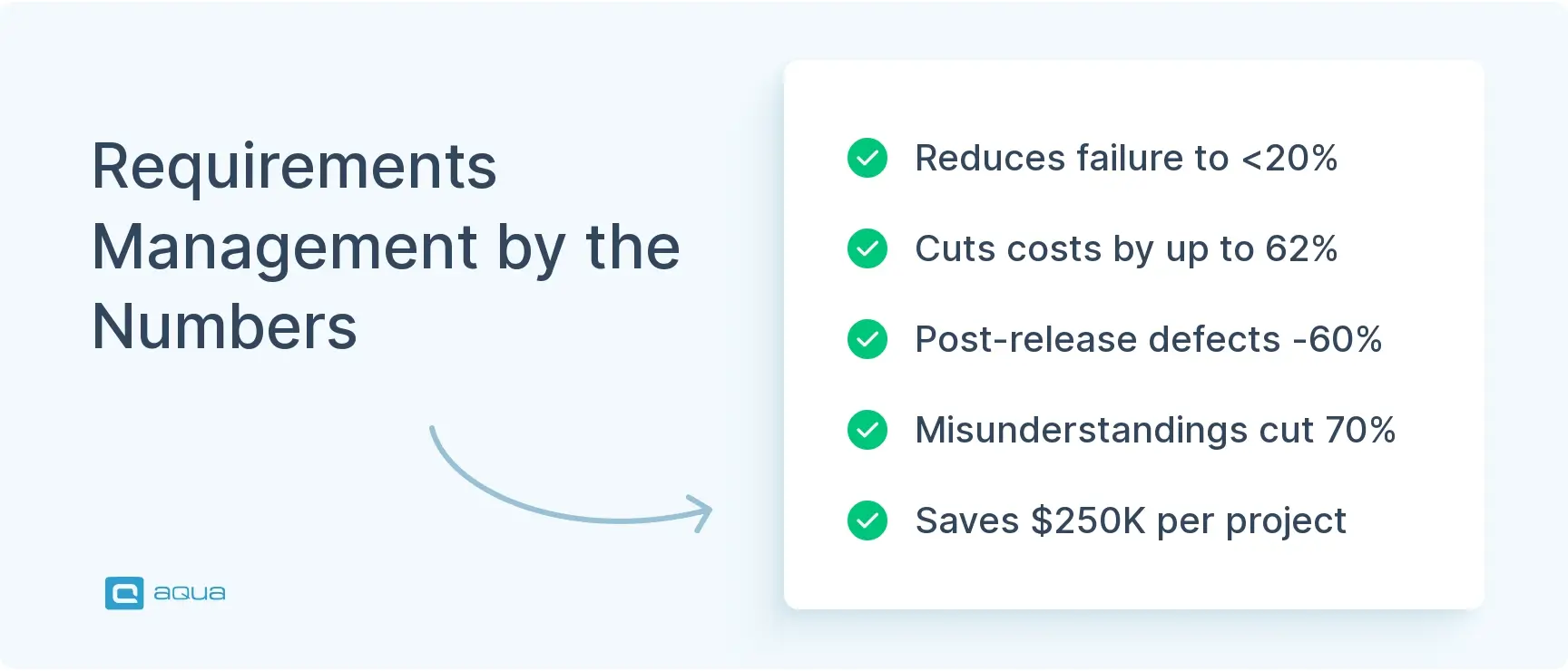Key takeaways
- Requirements management reduces project failure rates from 65-70% to below 20% when mature practices are implemented.
- Organizations with good requirements practices spend 62% less on similar projects compared to those with poor requirements management.
- Clear requirements documentation can reduce post-release defects by 40-60% and cut misunderstandings by 50-70%.
- Preventing just 50% of requirements-related rework on a $2.4 million project saves approximately $250,000.
- Effective requirements management creates structured communication channels between stakeholders and provides a framework for discussing, documenting, and tracking project deliverables.
When 38% of project failures stem directly from inaccurate requirements, can your team afford to skip this critical step? Discover how proper requirements management transforms project outcomes 👇
What is Requirements Management?
Requirements management is how you capture, document, analyze, and track what your project needs to deliver. It’s making sure you build what stakeholders actually need, not what someone thinks they need.
The process has several stages. Gathering requirements through interviews, workshops, surveys, and observation comes first. Documentation records those requirements in a structured format that everyone can access. Validation checks that requirements are clear, complete, and feasible. Tracking monitors implementation status throughout the project. Regular reviews keep requirements current as conditions change.
Requirements are split into two types. Functional requirements describe what the system does: specific behaviors, features, and capabilities. Non-functional requirements define how the system performs: security, performance, usability, and reliability. Both matter equally, though non-functional requirements often get ignored until problems surface.
Different stakeholders bring different perspectives. End users, business analysts, developers, testers, project managers, and executives all participate. Each sees the project differently. Requirements management balances these competing interests into a coherent vision.
All in all, it creates a shared understanding across your team. Without it, you risk building something technically sound that nobody wants or needs. This is one of the reasons why it is crucial for your business. Let’s look at all the reasons.
Why Requirements Management is Crucial for Project Success
Requirements management guides your entire project from concept to completion. Without it, teams work on assumptions and miss critical details. So you build things nobody needs.
Clear objectives everyone understands
Clear requirements give everyone a shared understanding of what needs to be built. Development teams know exactly what features are needed and how they should function. They work efficiently instead of constantly asking for clarification or redoing work. Testing teams know what to validate. Stakeholders know what to expect.
Structured communication between stakeholders
Requirements management structures communication between stakeholders. Instead of chaotic emails, hallway conversations, and guesswork, you have a formal system for discussing and tracking what the project needs to deliver. Critical requirements don’t don’t get missed or misinterpreted.
Prevention of costly failures
Poor requirements management kills projects. Research shows roughly 38% of project failures stem from inaccurate or incomplete requirements. Teams build features users don’t need while missing ones they do. Budgets rise. Timelines slip. Products miss their purpose.
Better handling of changes
Requirements change during projects. When those changes aren’t communicated properly, developers build obsolete features while testers prepare for functionality that no longer exists. Confusion spreads. Efficiency drops. Everyone gets frustrated.
Proven impact on success rates
The numbers tell the story. Projects with solid requirements practices fail less than 20% of the time. Projects with poor requirements management fail 65 to 70% of the time. That gap shows how much requirements management matters for project success.
When discussing the foundation of successful projects, there’s one critical dimension that elevates requirements management beyond documentation: integration with comprehensive testing. While robust requirements management creates clarity, organizations that seamlessly connect requirements to testing achieve remarkably higher project success rates.

This is where aqua cloud shines as a complete requirements management solution. With aqua, you can build flexible requirement hierarchies, create direct links between requirements and test cases, and visualize coverage gaps through interactive dependency graphs. The platform’s domain-trained AI Copilot takes this further by automatically generating high-quality test cases from your requirements in seconds. No more manual translation of requirements into test scenarios. Teams using aqua report saving approximately 12.8 hours per user weekly while ensuring 100% requirements coverage through automated traceability and documentation. Whether you’re in a regulated industry requiring audit trails or simply want to elevate quality while reducing costs, aqua provides the end-to-end visibility that turns requirements management from a documentation exercise into a strategic advantage.
Transform your requirements into testable assets with 100% traceability in one click
The Key Benefits of Effective Requirements Management
You understand why requirements management matters. Now let’s look at what it actually does for projects.
Reduction of Misunderstandings and Errors
Clear, documented requirements cut down misunderstandings between stakeholders and development teams. When requirements are ambiguous, different team members interpret them differently. Developers build what they think is needed based on incomplete information. The disconnect shows up late in the project when fixes cost serious money and time.
Well managed requirements give everyone a single source of truth to reference. Developers build what stakeholders actually need. Fewer errors occur. Less rework happens.
The cost difference matters. Organizations with mature requirements practices spend up to 200 times less fixing defects compared to discovering requirements issues after implementation. That early clarity saves money throughout the entire project.
More Efficient Resource Planning
Once you’ve reduced errors and misunderstandings, resource planning becomes more accurate. Well-defined requirements let project managers estimate the skills, team size, and timeframe needed for delivery. This prevents resource shortages that delay projects and excess capacity that wastes budget.
Documented requirements help forecast resource demands with greater accuracy. Teams identify skill gaps early and address them through training or hiring instead of discovering critical shortages mid project. One provider using this approach forecasted demand 12 to 24 months ahead and allocated resources weekly based on requirement priorities.
Requirements prioritization supports smarter resource allocation too. Understanding which requirements are most critical lets teams assign their best people to the most important work. Limited resources focus on delivering maximum business value instead of spreading too thin.
Enhanced Traceability and Transparency
Better resource planning leads to another advantage: complete visibility across the project. Requirements traceability creates clear links between business needs, requirements, design elements, code, and test cases. This shows how different components relate and how changes in one area affect others.
When a requirement changes, traceability helps teams quickly identify all affected components. Impact analysis becomes faster and more accurate. In regulated industries like healthcare, automotive, and finance, this capability is essential. Compliance depends on proving all requirements have been properly implemented and tested.
Transparency keeps stakeholders informed throughout the project. Instead of waiting for periodic status reports, they can access current information about requirements status, planned changes, and implementation progress. This visibility builds trust and prevents surprises that damage project credibility.
Assurance of Product Quality
Traceability and transparency directly improve product quality. Requirements management establishes clear acceptance criteria. Teams know exactly what success looks like and build features that meet those standards the first time. These criteria also provide a foundation for comprehensive test planning, ensuring quality assurance activities verify all aspects of the requirements.
Well-managed requirements enable early quality checks throughout development. Requirements reviews catch inconsistencies, ambiguities, and gaps before they affect implementation. This preventive approach beats discovering quality issues during testing or after release.
Organizations implementing systematic requirements management report 40 to 60% reductions in post release defects. For QA teams, clear requirements make testing more effective and targeted, resulting in more thorough coverage and better defect detection.
Compliance with Industry Standards and Regulations
Quality improvements matter even more in regulated industries where compliance is mandatory. Requirements management provides the documentation and traceability needed for compliance. Many standards and regulations explicitly require organizations to demonstrate requirements traceability from business needs through implementation and testing.
Medical device development under FDA regulations and IEC 62304 requires comprehensive requirements documentation and traceability. Automotive teams preparing for ISO 26262 certification rely on requirements management to confirm that safety critical requirements connect directly to validation tests. Without proper requirements management, achieving certification becomes significantly more difficult and time consuming.
Beyond regulatory benefits, proper requirements management helps organizations maintain consistency across products and services. This consistency improves user experience and strengthens brand identity, particularly for companies with diverse product portfolios.
Long-term Advantages of Systematic Requirements Management
The immediate benefits matter, but the long term advantages build lasting competitive advantage when you get requirements management right.
Improved Competitiveness and Innovation Capabilities
Mature requirements management practices let you evaluate and implement new ideas faster. This speed creates competitive advantage in markets where innovation determines success. When you have established processes for capturing, analyzing, and implementing requirements, you move from concept to delivery more efficiently than competitors struggling with chaos.
Requirements management also creates a foundation for sustainable differentiation:
Process excellence that competitors can’t copy – Competitors can copy your products and hire away your talent, but well established requirements processes embed excellence into your organizational DNA. These processes enable consistent execution that becomes increasingly difficult for competitors to replicate over time.
Solutions that address real market demands – Companies known for innovation trace their capabilities to superior requirements practices. When you clearly understand customer needs and systematically translate them into product requirements, you build solutions that genuinely address market demands rather than simply adding features competitors already offer.
Managing, maintaining, and executing the verification/validation of requirements is critical in meeting and, sometimes exceeding that bottom line. Whether you play a role in the tail end of requirements verification and satisfaction, or a role up front defining stakeholder needs or deriving system requirements, you are actively working towards the release of a product that ensures the bottom line is met.
Scalability of Project Management Practices
As your organization grows, requirements management provides the structure to scale project activities without proportional increases in complexity and failure rates. Strong requirements management enables you to manage multiple simultaneous projects. This way, you can coordinate distributed teams and maintain consistency across product lines.
With mature requirements management, you start new projects more efficiently. You build on existing processes and content instead of reinventing approaches for each initiative. New team members get up to speed faster because processes are consistent. Growth doesn’t automatically mean chaos.
The scalability advantages matter especially when you’re expanding globally or moving into new markets. Requirements management helps you maintain quality and consistency even as your teams grow and become more distributed. You avoid the fragmentation that usually comes with rapid expansion.
Cost Reductions Associated with Better Defined Requirements
The most compelling long-term advantage is the significant cost savings that accumulate over time. Organizations with mature requirements management spend 62% less on similar projects compared to organizations with poor practices. This dramatic difference comes from several factors:
Prevention of expensive rework – Well-defined requirements mean you build the right features the first time rather than iterating through multiple correction cycles. Preventing just 50% of requirements-related rework on a $2.4 million project saves approximately $250,000.
Reduction of technical debt – When requirements ambiguity forces your developers to make assumptions or implement temporary solutions, technical debt accumulates. This means future work is needed to properly address deferred decisions. Systematic requirements management prevents this debt as you clarify expectations upfront. Your team builds solutions correctly initially rather than planning for eventual refactoring.
Improved resource utilization – Your team spends less time in clarification meetings and less effort correcting misunderstandings. More time goes to building valuable features. These efficiency gains compound over time. It means huge cost advantages compared to competitors struggling with poor requirements practices.
Implementing Effective Requirements Management in Your Organization
You understand the benefits. Now here’s how to actually make requirements management work in your organization.
Training Your Team on Requirements Management Software
Requirements management tools only work if your team knows how to use them. Invest in comprehensive training that covers both basic functionality and advanced capabilities like traceability management, impact analysis, and reporting. But don’t stop at tool training. Your team also needs to understand requirements elicitation techniques, how to write clear requirements, and how to manage changes effectively.
AI software for requirements management (like aqua cloud) provides centralized storage, version control, collaboration features, and automated traceability. These capabilities cut administrative overhead while improving accuracy and consistency. The benefits of requirements management software become obvious when you actually know how to use it properly.
Set up a community of practice where team members share experiences, discuss challenges, and exchange best practices. This ongoing learning keeps the momentum going and continuously improves your requirements management capabilities beyond initial training.
Building Your Requirements Management Plan
Your requirements management plan is your roadmap for handling requirements throughout the project lifecycle. Address these key questions:
- What process will you use for eliciting, documenting, and validating requirements?
- How will you prioritize and approve requirements?
- What attributes will you capture for each requirement like priority, source, and acceptance criteria?
- How will you establish and maintain requirements traceability?
- What change management process will govern requirements modifications?
- What tools will you use and how will you configure them?
Make the plan fit your specific needs. Consider your project complexity, team distribution, regulatory environment, and development methodology. Skip the one-size-fits-all approach.
Start with a pilot project to test and refine your approach before rolling it out broadly. This controlled implementation lets you adjust based on actual experience while building a success story that inspires wider adoption. Expect to iterate as you learn what works in your specific context.
Implementing effective requirements management is a journey. You’ll continuously refine your approach as you gain experience and as business needs evolve. Start with a solid foundation and build incrementally, focusing on aspects that deliver the most value for your situation.
As we’ve seen, effective requirements management delivers crucial benefits: reduced misunderstandings, more efficient resource planning, enhanced traceability, and improved compliance. But implementing these practices requires the right tooling to realize their full potential.
Perfect Requirements Management Tool: aqua cloud
Requirements management needs a test management tool that handles the entire lifecycle without forcing you to jump between platforms. aqua cloud delivers that in one unified system.
Flexible requirement structures that match how you work
Create requirement hierarchies that fit your project structure. Epics, user stories, features, technical specs. Organize them however makes sense for your team. Link requirements to each other to show dependencies and relationships. The structure adapts to your methodology, whether you’re working agile, waterfall, or hybrid.
Complete traceability from requirements to testing
Every requirement connects directly to test cases, defects, and releases. You see which requirements have test coverage and which don’t. When a requirement changes, you know immediately which tests need updating. When a defect appears, you trace it back to the original requirement. This end-to-end visibility eliminates gaps and keeps everyone aligned.
AI that generates test cases from your requirements
aqua’s domain-trained AI Copilot reads your requirements and generates structured test cases automatically. It understands testing context, not just generic text patterns. The output is immediately usable, saving you an average of 12.8 hours per week. You write requirements once and get comprehensive test coverage without manual translation.
Collaboration built in, not bolted on
Requirements don’t live in isolation. aqua integrates with Jira, Azure DevOps, and Confluence, so requirements sync with your existing workflow. Teams collaborate in real time. Stakeholders review and approve requirements without switching tools. Comments, change history, and discussions stay attached to requirements for complete context.
Compliance and audit trails that actually work
Every change to every requirement gets tracked automatically. Who changed it, when, and why. Baseline versions preserve historical snapshots. Impact analysis shows ripple effects before you make changes. For regulated industries, this audit trail proves compliance without extra documentation work.
Custom fields and workflows that fit your process
Configure requirement attributes that matter to your organization. Priority, risk level, business value, compliance category. Whatever you need to track. Build approval workflows that match your governance requirements. aqua flexes to your process instead of forcing you into a rigid structure.
So aqua’s AI Copilot generates test cases from requirements in seconds, complete traceability connects every requirement to tests and defects, integrations with Jira, Azure DevOps, and Confluence keep your workflow seamless, and comprehensive audit trails satisfy compliance requirements. Ready to transform your requirements management from administrative overhead into competitive advantage?
Achieve 62% lower project costs with intelligent requirements management in aqua
Conclusion
Requirements management determines whether your projects succeed or fail. Solid requirements management cuts down misunderstandings between teams and stakeholders. Resources get planned more accurately. Quality improves because teams know exactly what to build. Compliance becomes easier to demonstrate. Over time, these improvements compound. Your organization becomes more competitive. Projects scale without chaos. Costs drop significantly compared to competitors still struggling with poor requirements. The benefits of requirements management software and proper processes show up in your budget, your product quality, and your stakeholder satisfaction. If your projects struggle with unclear requirements, wasted effort, or missed expectations, requirements management is worth the investment.

















